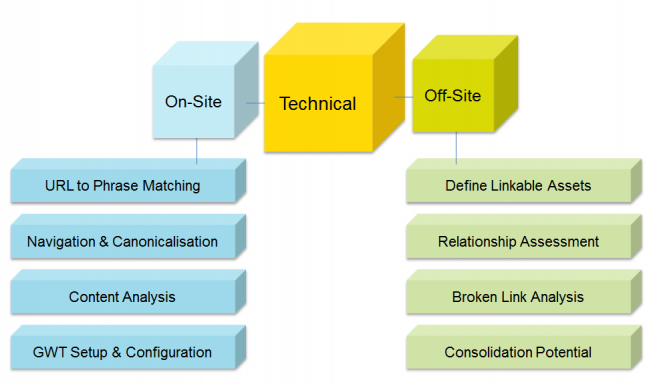
Learn about the key elements behind our most successful enterprise SEO campaigns.
Enterprise SEO brings a whole new set of challenges on top of usual set of best optimisation practices and one of the most momentous obstacles with large-scale campaigns is the sheer scale of things.
The General Rule of Scalability
Avoid manual work and find ways to automate anything repetitive or large in scale.
Scalability is the key ingredient which spans across various facets of big campaigns including strategy design, research activities, link building, technical assessment and implementation. For example in multi-dimensional product/service websites, focusing on a single vertical can be useful as a matter of testing a new method or coming up with a proof of concept. Usual SEO workflow structure will simply not be scalable enough to execute across thousands of pages and keywords.
So whatever you do, do not get stuck in doing the usual manual legwork in any step of the optimisation process. There are tools and methodologies available out there which can and will bring you to a near equilibrium to how you manage your campaign budget and resources.
Strategy & Decision Making
Set tangible goals and targets through software-aided rendering of all available data.
Basic Overview
Knowing what to do and when is a matter of thorough understanding of risks and opportunities coming from in-depth research. A typical SEO campaign may contain the following elements:
Phrase Research
Define best keywords by search volume utilising Google Keyword Tools, Webmaster Tools and Analytics. Refine results using sorting criteria designed to produce ROI-based phrase shortlist ready for campaign.
Competitive Analysis
This is the next step in the phrase refinement process which adds a layer of competitive strength to already defined phrases of interest in order to understand the likelihood and timeframes required to achieve rankings, traffic and ROI.
Targeting
By combining phrase research and competitive analysis we can produce a targeting matrix knowing exactly which set of phrases to match with what URL. This is essential for on-site optimisation activities and link building which are to follow.
Project Timeline
Defined timeline with expected activities, goals and outcomes to be noted each month of the campaign.
Senior Management: Expectations & Approach
Corporate SEO objectives can vary in nature so it’s important to understand how the management measures success. Setting their expectations right will avoid issues with budget and secure a healthy, long-term SEO campaign. During your research you will discover many unique opportunities, however do not lose track of what matters to your superiors. They may have a completely different idea of a successful SEO campaign than you do and you do not wish to disappoint anyone.
You might find it hard to believe but others may not find your phrase research methodology that exciting. When you present your ideas and concepts use plenty of visual aids, comparison charts, summarise the message and always include tangible benefits.

Data Gathering: Look Everywhere & Record Everything
Arm yourself with as much data as you can as early as possible, you may need to chase different departments but stay persistent and remind everyone who owes you your data or access to relevant tools. This includes:
- Analytics Suites
- Google Webmaster Tools
- Raw Log Files
- PPC Campaigns
- Affiliate Campaigns
- Previous SEO Data / History
- Whitepapers & Case Studies
- Offline Content
Maintain good records and chronology of exported/accessed data. It’s also a good idea to write down departments, names and contact details of people responsible for data access. Take the initial snapshot of the entire state of the website and its performance in search engines. Archived data will ensure smooth comparative analysis at a later stage and may even help you present key benchmark when reporting to the management.
Rendering Data: Finding Patterns & Opportunities in Large-Scale Data Files
Your SEO budget is never unlimited, but others’ expectation of your performance may get pretty close to it. Arm yourself with some positive news right at the beginning. Small wins will help you get a bigger budget – sooner.
Where to start?
If you work on a large corporate website, the odds are, it may already have a decent status in search engines and a smart thing to do would be to identify the easiest targets with the greatest success potential. Note that the ‘success’ can be measured in different ways (e.g. traffic, sales, leads, sign-ups) but none of that will happen unless the search engine position is where it should be.
Phrase Potential Calculation
At Dejan SEO we’ve utilise an in-house phrase targeting methodology based on potential calculation formula. We use up to two data sources (Google Webmaster Tools and Google Keyword Tool) which include search volumes, impressions, clicks, CTR values and average ranking positions.

Re-prioritised phrase targeting: Apply customised traffic and revenue projections to search volumes
The tool we use also enables us to add conversion rate and goal values to phrase potential calculation and produce estimated financial outcomes and projections based on both keyword-specific and site-average performance. This enables us to order our list of phrases and allocate our budget accordingly.
A wise thing to do is to allocate a fraction of your resources to what may be a set of easy targets while you continue to chisel away at your long-term goals.
Technical Wizardry
Understanding on-site problems through near-magic.
Search engines cost a lot of money to run and they require incredible amounts of storage and processing power. The last thing they want to do is to go in navigational loops and index duplicate pages on a broken website. Yes, it’s often navigational and architecture problems that can act as bottlenecks in your SEO efforts. Google now employs various filters (e.g. Panda) to devalue websites with thin repetitive content.
Problem Visualisation
Most humans cannot easily comprehend plain data (CSV lists, XML sitemaps) but we can identify problems in seconds if visualised in the right way. Here’s an example of a website troubled by faceted navigation, starting from the top level sub-category:

In an isometric overview above we observe a single sub category breaking up into multiple navigational items, each splitting up into more up to 16 levels deep, each time generating more pages than before. If we attempted to show all categories at once we would be looking at a complex hypercube, not so useful. The problem grows even larger in a deeper linear analysis. Let’s zoom out a bit:

From the image above we can see that the navigational structure of this website leans towards infinity at an increasing rate. Although a healthy PageRank of 7 or 8 may disperse bots to, and index as many as 100 million pages this is not necessarily a good thing. This is not just because of search quality filters but also because of sub-optimal link equity distribution and intra-competitive pages within a single domain.
The visualisation above was generated using a desktop application called PowerMapper, but the poor thing crashed before ‘finishing’ the infinite website structure. For more elaborate scanning you may wish to employ something more robust such as 80 Legs which utilises a network of machines and has an impressive set of customisable crawling parameters. The crawling data can be manipulated in any linked data processing application such as Gephi and produce fine visualisations such as the one we did for one of our clients’ websites:

The visualisation above illustrates the top linked pages within a single domain and its connections. The size and colour of each node is determined by the page in-degree or “internal PageRank”. Using the same tool-set we can also project the internal promotion and importance of different pages and model outcomes of various linking structures.
Note that there are many useful visualisation and mapping applications out there suited for different purposes so it’s a good idea to try out a few and discover which one may be most compatible with your data and requirements.
Visualisation is helpful indeed, but a holistic overview requires much more work than that. In the following diagram we see a typical breakdown of typical activities:

On-Site Review
Remember, things may move slowly and there could be long waiting periods until your on-site recommendations are implemented. There are often numerous items to fix from the technical point of view, but after forming a sound strategy you can prioritise your work and attend to high priority items first.
URL to Phrase Matching
This task is related to strategic targeting exercise and enables us to prevent any double-targeting or lack of URLs for any of strategically selected phrases.
Navigational & Canonical Setup
Ensures that there is always only one canonical version of each URL on your website and that navigation flows with optimum SEO efficiency.
Content Analysis
Checks for any content issues, accessibility of content and duplication.
Google Webmaster Tools Setup & Configuration
Main channel of communication between Google and your website. Enables us to easily detect any known issues and correct problems directly with Google.
Off-Site Review
Assessment of ranking factors not directly related with the technical setup or content located on the site itself.
Define Linkable Assets
Discover the most popular content on your website by observing links and traffic data.
Relationship Assessment
Learn about how you are connected in the business world and with your customers to extract value and potential link partnerships.
Broken Link Analysis
Finding out if any links are going to wrong pages or expired content.
Consolidation Potential
Discovering links which could be implemented better or online references and mentions that could turn into links.
Ongoing Activities
Looking after SEO performance on a month-to-month basis ensuring that your SEO runs smoothly, from technical issues and content to inbound links.
Implementation of SEO-friendly marketing policies
Much of your SEO can happen on the fly and without engagement of an SEO company. Try to point out areas where you can contribute to your SEO by adapting your daily marketing activities.
Link building campaign
Appropriate management of your link building campaign to secure a steady flow or links for your domain.
Content development
Development of creative content to serve as a marketing device, social booster and a link generator.
Risk assessment and monitoring
Understanding risks is essential to preservation and maintenance of your rankings for the long term. There are certain rules which search engines want webmasters to respect. Penalties can apply if those rules are broken.
Team Training
Start with a team-wide presentation introducing essential terms, concepts and activities. During this session all participants need to be familiarised with search marketing strategy, agendas and desired outcomes. The presentation should end with a Q&A segment. Each consecutive training session must be designed for each team or person depending on their role in the team (marketing, web design, programming, content, PR, advertising, social media, management).

During the training sessions each team member will learn on what they can do to help you reach you strategic search marketing goals.
Will this work? Honestly, no.
At first everyone will be eager and excited about SEO but you will soon learn that you can never get a complete cooperation from every department on a permanent basis. Do not get discouraged and use what you have available to you as there is no way around it.
2012 and Beyond
Here are a few emerging trends and technologies relevant to SEO:
Quality
Maintaining a lean, canonicalised and well laid out website is one piece of the puzzle. Google’s perception of ‘quality’ goes deeper and they attack manipulative techniques more aggressively each year. Ensure your rankings do not depend on purchased or rented links coming from questionable sources. The best way to do that is to perform an in-depth link analysis and look for unusual patterns.
Summary list of things to avoid:
- Index Bloat
- Thin, automated, repetitive content pages
- Indexable search results and tags
- ‘SEO’ keyword pages
- Over-Optimise
- Anchor Text
- On-Page
- Link Schemes
- Automated
- Blog Networks
- Spam
- Mass-Scale ‘Clever’ Tactics
- Poor UX
- Navigation, Design & Layout
Google+
Sceptics argue that Google’s social platform will never take off, though there is solid proof that Google is more serious about their social venture than anything else before. They will do everything it takes to make it a success, and when they do go mainstream you will want to already have a well-established profile and broad presence with plenty of social endorsements (+1’s, shares, mentions, circles).
Structured Data
Schema.org standard is not there just for shopping carts. There are many uses of structured data and search engines will continue to advance and diversify the complexity of their results and aggregate data. For now, here’s one significant incentive to encourage you to jump on-board: click-through increase from rich-snippet based search results.
Authorship
Authorship ties in with both search quality and Google+ and represents a significant element in both social and knowledge graph. In the future Google will continue to favour content from trusted authors and their social influence will be quite significant. Just like with schema.org mark-up, author snippet with a thumbnail increases the click-through rate significantly. Remember, just like with anything in enterprise SEO you need to ensure that authorship is embedded in the website’s CMS and guidelines created for authors and contributors on how to verify their authorship on their end. You don’t want to do this manually each time.
Discussion
Tell us about your experience with enterprise SEO on Google+
Downloads
Enterprise SEO presentation at SMX Sydney 2012: Download slides
Other Recommended Articles
If you like this article you might also want to read these:
Dan Petrovic, the managing director of DEJAN, is Australia’s best-known name in the field of search engine optimisation. Dan is a web author, innovator and a highly regarded search industry event speaker.
ORCID iD: https://orcid.org/0000-0002-6886-3211

Great post Dan, extremely detailed as always. You made a really good point about setting expectations with management bottom-up. In my experience, working at an enterprise level requires a lot more accountability and any initiatives will always need to be tracked back against ROI or CPA. Do you get this a alot at Dejan? Have you ever been expected to forecast and account for potential uplift in organic traffic?
Question about data visualization tools. Have you played around with Tableau or Omniscope before?
Yes, that’s precisely it: If I put in $X what is the $Y? This is why it’s so important to pick your targets well. Traffic forecast is a major part in every large campaign we do. I have used Tableau but not Omniscope… will give it a try.
Be good to catch up with you at SMX and exchange/bounce some ideas!
Sounds good, I’ll be there tomorrow afternoon.
Really interesting post Dan. You mention Google+ as a growing social platform but what is your take on social contributing to search engine rankings? I viewed an infograph on just that last week where the company behind it said to have proof of social engagement increasing positioning.
There is no doubt whether Google will trust their own social network signals and use as part of the ranking mix.
Thanks for your post.
http://infinitevizionzz.blog.com/2012/04/04/the-popular-web-design-company-in-london/
Hai Dan.
This post is really amazing, but i think that On-Page SEO also matters a lot when you are trying to optimize your webpage. The only question that i have is that, If suppose i have a keyword as “search engine optimization technique” but as the year pass i have a new post with new search engine optimization technique. So could i change the Url to do Off-page SEO on the same keyword?
When we talk about enterprise SEO then we have to pay attention towards those SEO strategies who deal with large amount of data .A lot of tools are available in the market who can provide assistance in implementing strategies upon large scale data. Well On page SEO and off page SEO both have their individual role in SERPs so better to check performance after implementing these strategies.